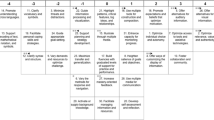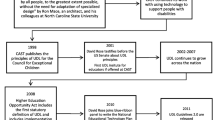Abstract
Based upon systematic reviews of the use of universal design (UD) in higher education, the findings of the current review underscore the benefits of applying UD for all students in postsecondary education settings. Major findings include the following. The term universal design for learning is among the most frequently used in the literature to describe UD in education compared to other terms such as universal instructional design and universal design of instruction. Communities of learning (e.g., discussion or learning activity groups) and hands-on activities (e.g., modifications of individualized education plans and learning technology implementations) delivered as online or face-to-face (F2F) are among the two most common forms of learning activities used in the application of the UD principles. A relationship may exist between learners and delivery mode, in that traditional students may be more adept at taking F2F courses, whereas nontraditional learners may find online courses more attractive. Furthermore, technology may be independent of delivery mode, at least in the context of F2F and online. Finally, effect sizes were reported in only 4 of the 15 studies examined.
Similar content being viewed by others
References
Basham, J. D., Lowrey, A. K., & deNoyelles, A. (2010). Computer-mediated communication in the universal design for learning framework for preparation of special education teachers. A Journal of Special Education Technology, 25(2), 31–44. https://doi.org/10.1177/016264341002500203
Burgstahler, S. (2009). Universal design of instruction (UDI): Definition, principles, guidelines, and examples. Seattle, WA: University of Washington. Retrieved from https://www.washington.edu/doit/universal-design-instruction-udi-definition-principles-guidelines-and-examples
Center for Applied Special Technology (CAST). (2019a). CAST timeline. Retrieved from http://www.cast.org/about/timeline.html
Center for Applied Special Technology (CAST). (2019b). The UDL guidelines. Retrieved from http://udlguidelines.cast.org
Centre for Excellence in Universal Design. (2014a). The 7 principles. Retrieved from http://universaldesign.ie/what-is-universal-design/the-7-principles/the-7-principles.html
Centre for Excellence in Universal Design. (2014b). What is universal design? Retrieved from http://universaldesign.ie/What-is-Universal-Design/
Chen, S.-J. (2007). Instructional design strategies for intensive online courses: An objectivist-constructivist blended approach. Journal of Interactive Online Learning, 6(1), 72–85.
Connell, B. R., Jones, M., Mace, R., Mueller, J., Mullick, A., Ostroff, E., … Vanderheiden, G. (1997). The principles of universal design. Retrieved from https://projects.ncsu.edu/design/cud/about_ud/udprinciplestext.htm
Dallas, B. K., Long, G., & McCarthy, A. K. (2016). Assessing the effects of closed-captioning on undergraduate students’ recall and understanding of video-based information. Journal on Excellence in College Teaching, 27(2), 117–129.
Dean, T., Lee-Post, A., & Hapke, H. (2017). Universal design for learning in teaching large lecture classes. Journal of Marketing Education, 39(1), 5–16. https://doi.org/10.1177/0273475316662104
Harper, K. A., & DeWaters, J. (2008). A quest for website accessibility in higher education institutions. Internet and Higher Education, 11(3/4), 160–164. https://doi.org/10.1016/j.iheduc.2008.06.007
Hitchcock, C., & Stahl, S. (2003). Assistive technology, universal design, universal design for learning: Improved learning opportunities. Journal of Special Education Technology, 18(4), 45–52. https://doi.org/10.1177/016264340301800404
Izzo, M. V., Murray, A., & Novak, J. (2008). The faculty perspective on universal design for learning. Journal of Postsecondary Education and Disability, 21(2), 60–72.
K12 Academics. (2019). Other applications of universal design in educational settings. Retrieved from https://www.k12academics.com/pedagogy/universal-design-instruction/other-applications-universal-design-educational-settings
Keengwe, J., & Kidd, T. T. (2010). Towards best practices in online learning and teaching in higher education. MERLOT, 6(2), 533–541.
Kumar, K. L., & Wideman, M. (2014). Accessible by design: Applying UDL principles in a first year undergraduate course. Canadian Journal of Higher Education, 44(1), 125–147.
Lombardi, A., Vukovo, B., & Sala-Bars, I. (2015). International comparisons of inclusion instruction among college faculty in Spain, Canada, and the United States. Journal of Postsecondary Education and Disability, 28(4), 447–460.
McGhie-Richmond, D., & Sung, A. N. (2013). Applying universal design for learning to instructional lesson planning. International Journal of Whole Schooling, 9(1), 43–59.
McGuire-Schwartz, M. E., & Arndt, J. S. (2007). Transforming universal design for learning in early childhood teacher education from college classroom to early childhood classroom. Journal of Early Childhood Teacher Education, 28(2), 127–139. https://doi.org/10.1080/10901020701366707
McGuire, J. M., & Scott, S. S. (2006). An approach for inclusive college teaching: Universal design for instruction. Learning Disabilities: A Multidisciplinary Journal, 14(1), 21–31.
Morningstar, M. E., Frey, B. B., Noonan, P. M., Ng, J., Clavenna-Deane, B., Graves, P., … Williams-Diehm, K. (2010). A preliminary investigation of the relationship of transition preparation and self-determination for students with disabilities in postsecondary educational settings. Career Development and Transition for Exceptional Individuals, 33(2), 80–94. https://doi.org/10.1177/0885728809356568
Ofiesh, N. S., & McAfee, J. A. (Eds.). (2006). Universal design in higher education. Huntersville, NC: The Association on Higher Education And Disability.
Orkwis, R., & McLane, K. (1998). A curriculum every student can use: Design principles for student access. ERIC/OSEP topical brief no. ED423654. Reston, VA: ERIC/OSEP Special Project.
Palmer, J., & Caputo, A. (n.d.). The universal instructional design implementation guide. Guelph, ON: University of Guelph. Retrieved from https://opened.uoguelph.ca/instructor-resources/resources/uid-implimentation-guide-v13.pdf
Parker, D. R., Robinson, L. E., & Hannafin, R. D. (2007). “Blending” technology and effective pedagogy in a core course for preservice teachers. Journal of Computing in Teacher Education, 24(2), 49–54.
Roberts, K. D., Park, H. J., Brown, S., & Cook, B. (2011). Universal design for instruction in postsecondary education: A systematic review of empirically based articles. Journal of Postsecondary Education and Disability, 24(1), 5–15.
Schelly, C. L., Davies, P. L., & Spooner, C. L. (2011). Student perceptions of faculty implementation of universal design for learning. Journal of Postsecondary Education and Disability, 24(1), 17–30.
Scott, S. S., McGuire, J. M., & Shaw, S. F. (2003). Universal design for instruction: A new paradigm for adult instruction in postsecondary education. Remedial and Special Education, 24(6), 369–379. https://doi.org/10.1177/07419325030240060801
Seok, S. (2008). Teaching aspects of eLearning. The International Journal on E-Learning, 7(4), 725–741.
Seok, S., DaCosta, B., & Hodges, R. (2018). A systematic review of empirically based universal design for learning: Implementation and effectiveness of universal design in education for students with and without disabilities at the postsecondary level. Open Journal of Social Sciences, 6(5), 171–189. https://doi.org/10.4236/jss.2018.65014
Seok, S., DaCosta, B., & Yu, B. M. (2015). Spelling practice intervention: A comparison of tablet PC and picture cards as spelling practice methods for students with developmental disabilities. Education and Training in Autism and Developmental Disabilities, 50(1), 84–94.
Smith, F. G. (2012). Analyzing a college course that adheres to the universal design for learning (UDL) framework. Journal of the Scholarship of Teaching and Learning, 12(3), 31–61.
Spooner, F., Baker, J. N., Harris, A. A., Ahlgrim-Delzell, L., & Browder, D. M. (2007). Effects of training in universal design for learning on lesson plan development. Remedial and Special Education, 28(2), 108–116. https://doi.org/10.1177/07419325070280020101
Street, C. D., Koff, R., Fields, H., Kuehne, L., Handlin, L., Getty, M., & Parker, D. R. (2012). Expanding access to STEM for at-risk learners: A new application of universal design for instruction. Journal of Postsecondary Education and Disability, 25(4), 363–375.
U.S. Department of Education, Office for Civil Rights. (2007). Dear parent letter. Retrieved from https://www2.ed.gov/about/offices/list/ocr/letters/parent-20070316.html
U.S. Department of Education, Office for Civil Rights. (2011). Students with disabilities preparing for postsecondary education. Retrieved from https://www2.ed.gov/about/offices/list/ocr/transition.html
University of Guelph, Open Learning and Educational Support. (2016). Universal instructional design. Retrieved from https://opened.uoguelph.ca/student-resources/universal-instructional-design
Wynants, S. A., & Dennis, J. M. (2017). Embracing diversity and accessibility: A mixed methods study of the impact of an online disability awareness program. Journal of Postsecondary Education and Disability, 30(1), 33–48.
Zeff, R. (2007). Universal design across the curriculum. New Directions for Higher Education, 137, 27–44.
Zhang, Y. (2005). Collaborative professional development model: Focusing on universal design for technology utilization. ERS Spectrum, 23(3), 31–38.
Author information
Authors and Affiliations
Corresponding author
Editor information
Editors and Affiliations
Section Editor information
Rights and permissions
Copyright information
© 2020 Springer Nature Switzerland AG
About this entry
Cite this entry
Seok, S., DaCosta, B., Heitzman-Powell, L.S. (2020). Universal Design in Postsecondary Education: A Systematic Review. In: Spector, M.J., Lockee, B.B., Childress, M.D. (eds) Learning, Design, and Technology. Springer, Cham. https://doi.org/10.1007/978-3-319-17727-4_163-1
Download citation
DOI: https://doi.org/10.1007/978-3-319-17727-4_163-1
Received:
Accepted:
Published:
Publisher Name: Springer, Cham
Print ISBN: 978-3-319-17727-4
Online ISBN: 978-3-319-17727-4
eBook Packages: Springer Reference EducationReference Module Humanities and Social SciencesReference Module Education




